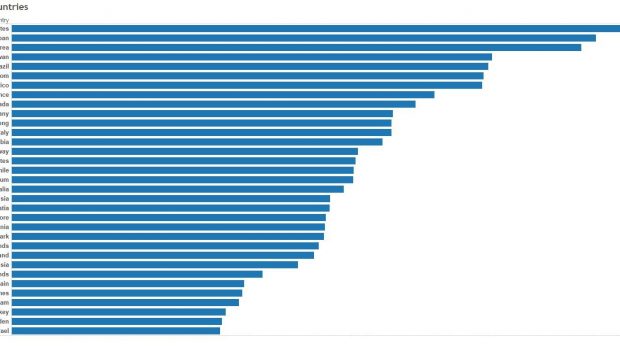Surge in Spam Campaign Delivering Locky Ransomware Downloaders
FireEye Labs is detecting a significant spike in Locky ransomware
downloaders due to a pair of concurrent email spam campaigns impacting
users in over 50 countries. Some of the top affected countries are
depicted in Figure 1.
Figure 1. Affected countries
As seen in Figure 2, the steep spike starts on March 21, 2016, where
Locky is running campaigns that coincide with the new Dridex campaigns
that were discussed in the blog, “Stop
Scanning My Macro”.

Figure 2. Detection on spam delivered malware
Prior to Locky’s emergence in February 2016, Dridex was known to be
responsible for a relatively higher volume of email spam campaigns.
However, as shown in Figure 3, we can see that Locky is catching up
with Dridex’s spam activities. This is especially true for this week,
as we are seeing more Locky-related spam themes than Dridex. On top of
that, we also are seeing Dridex and Locky running campaigns on the
same day, which resulted in an abnormal detection spike.

Figure 3. Dridex versus Locky spam campaign over time
Locky Ransomware spam
The new Locky spam campaign uses several themes such as “invoice
notice”, “attached image”, and “attached document themes”. See Figure
4 and Figure 5 for example campaign emails.

Figure 4. Urgent Invoice Campaign

Figure 5. Other Campaigns
The ZIP attachment as depicted in Figure 6 contains a malicious
JavaScript downloader that downloads and installs the Locky ransomware.

Figure 6. Zipped Content
In Figure 7, it is interesting to see that the recent Locky campaign
seems to prefer using a JavaScript-based downloader in comparison to
Microsoft Word and Excel macro-based downloaders, which were seen
being used in its early days.

Figure 7. Locky Downloader Mechanism
The preference for JavaScript downloaders could be due to the ease
to transform or obfuscate the script via automation to generate new
variants as depicted in Figure 8. As a result, the traditional
signature-based solution may not keep up with the variants where its
behavioral intent is the same. At the time of discovery, most of the
samples that we see are being detected by only one vendor, according
to VirusTotal.

Figure 8. Obfuscated JavaScript code
Conclusions
The volume of Locky ransomware downloaders observed is increasing
and it may potentially replace the Dridex downloader as the top
spammer. One of the latest victims of Locky is Methodist Hospital[1], where the victim was reportedly forced to pay
a ransom to retrieve their encrypted data. This suggests that the
cybercriminals are earning more from ransomware and this drives their
aggressive campaigns.
On top of that, JavaScript downloaders seem to be the preferred
medium for delivering its payload as it could be easily obfuscated to
create new variants.
Technical Analysis of a Locky Payload Sample
MD5 Sum: 3F118D0B888430AB9F58FC2589207988 (First seen on 2016-02-24
in VirusTotal)
Persistence Mechanism
- The malware does not contain a persistence mechanism. An
external tool or installer is required if the attacker desires
persistence. - The malware contains the ability to install the
following registry key for persistence; this functionality is
disabled in this variant.- HKCUSoftwareMicrosoftWindowsCurrentVersionRunLocky
- HKCUSoftwareMicrosoftWindowsCurrentVersionRunLocky
File System Artifacts
- The malware encrypts files on the system and creates new files
with the encrypted contents in the same directory with the following
naming convention:<16 random
hex digits>.locky- The
value is the ASCII hexadecimal representation of the first eight
bytes of the MD5 hash of the GUID of the system volume.
- The malware drops a ransom note provided by the C2
server in all directories with encrypted files and on the desktop of
the current user:- _Locky_recover_instructions.txt
- The malware drops an image on the desktop of the current
user:- _Locky_recover_instructions.bmp
Registry Artifacts
- The malware creates the registry key HKCUSoftwareLocky.
- id is set to a unique identifier generated for the
compromised system. - pubkey is set to a binary buffer
that contains a public RSA key. - paytext is set to a
binary buffer containing the recovery instructions. - completed is set to 1.
- id is set to a unique identifier generated for the
- The malware
changes the desktop background to a bitmap containing the ransom
instructions.- HKCUControl PanelDesktopWallpaper is set
to:
%CSIDL_DESKTOPDIRECTORY%_Locky_recover_instructions.bmp
- HKCUControl PanelDesktopWallpaper is set
Network-Based Signatures
Command and Control (CnC)
- The malware communicates with the following hard-coded hosts
using HTTP over TCP port 80. The malware also uses a domain name
generation algorithm as described below.- 188.138.88.184
- 31.41.47.37
- 5.34.183.136
- 91.121.97.170
Beacon Packet
- The malware beacon builds a HTTP POST request to /main.php as
shown in Figure 9. The POST data is encoded using a custom
algorithm.

Figure 9. HTTP POST request polling packet
(general packet structure)
Domain Generation Algorithm (DGA)
This sample contains a domain name generation algorithm that is
based on the current month, day and year. There are eight possible
domains per day and the domains change on the first of the month and
on even numbered days. Figure 10 contains Python code to generate the
eight possible domain names for the current date.

Figure 10. Locky Domain Generation Algorithm
[1] http://arstechnica.com/security/2016/03/kentucky-hospital-hit-by-ransomware-attack/








Gloss